Lepcis Magna, Decumanus
Lepcis Magna: Phoenician colony, later part of the Carthaginian empire, the kingdom of Massinissa, and the Roman empire. Its most famous son was the emperor Septimius Severus (r.193-211).
Decumanus
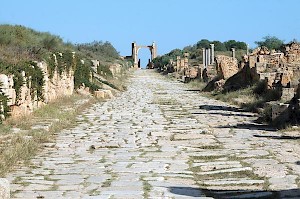
If the Romans could freely design their cities, they would start by creating two roads, the Cardo Maximus and the Decumanus Maximus, perpendicular to each other and crossing at the Forum, the central square and religious, commercial, and administrative center of the town. Lepcis Magna, however, was already an ancient city when the Romans established control, and although it had a street that could be considered a Cardo, there was no real Decumanus.
However, there was an ancient road along the city, a section of the road that connected Alexandria and the Cyrenaica, passing along Lepcis, Oea, Sabratha, with Carthage, and Mauritania in the far west. At the crossroads, there was a simple milestone, originally about 350 m outside the city. The place is now dominated by the Arch of Septimius Severus.
This street, today commonly referred to as Decumanus, passed along the city, which expanded rapidly in the first and second centuries. As a result, it was eventually inside the town. An honorific arch, dedicated to Marcus Aurelius, was erected over it, and there must be other monuments, still covered with earth, because this part is the city has not been excavated.
On one of the walls, not far from the Hadrianic Baths, we can find this apotropaic (evil-averting) sign, which is called a fascinum. It is a legged and winged phallus, which appears to be attacking the evil eye.
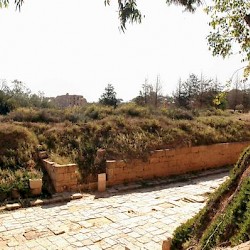 Lepcis Magna, Decumanus |
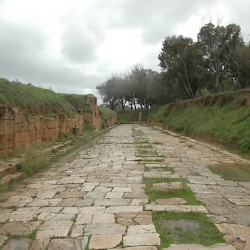 Lepcis Magna, Decumanus, Cloaca |
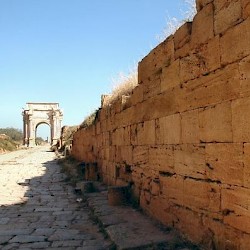 Lepcis Magna, Decumanus and Arch of Septimius Severus |
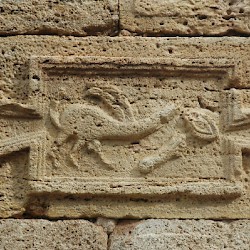 Lepcis Magna, Decumanus, Fascinum |